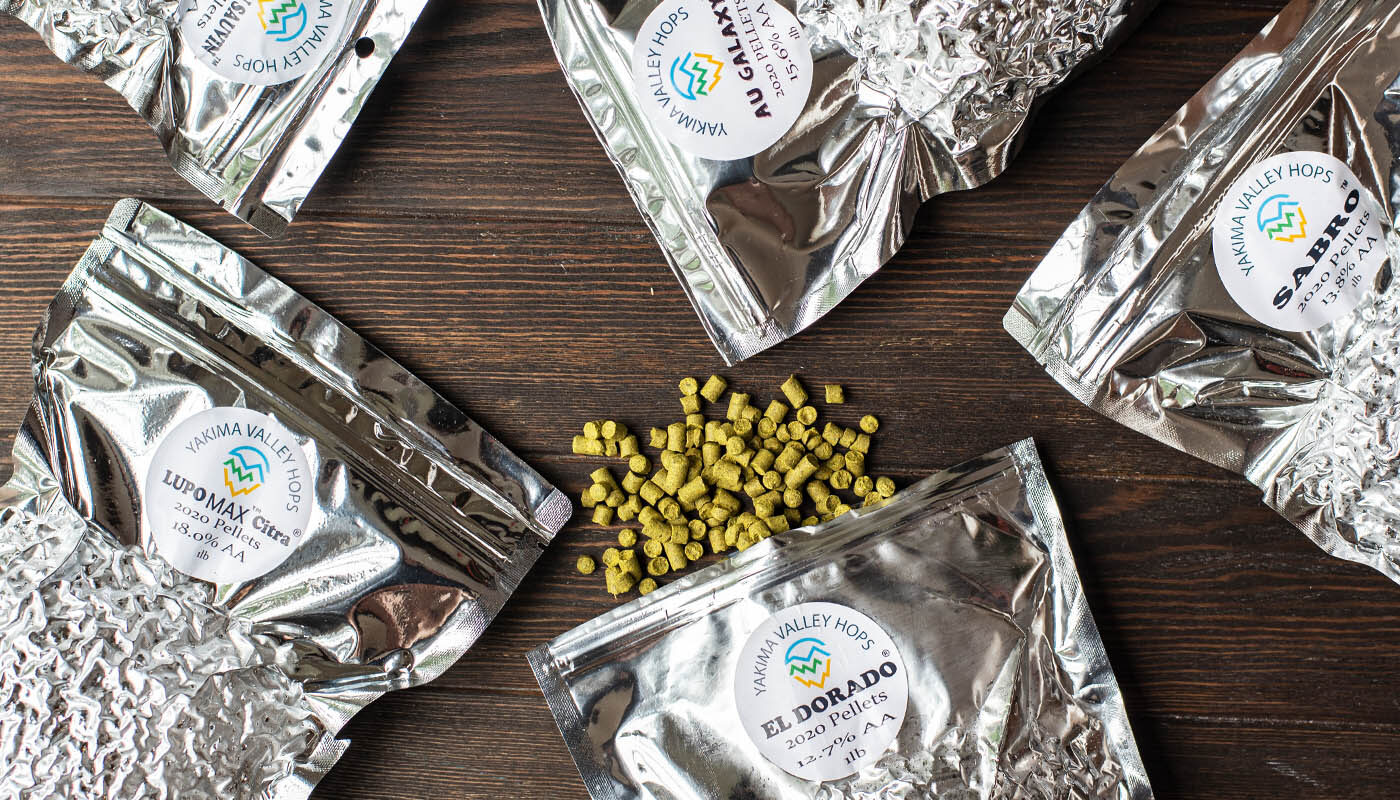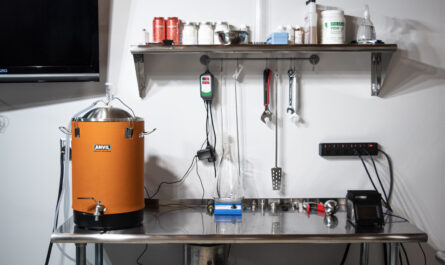I recently virtually sat down with my friends over at Yakima Valley Hops (YVH) to chat about hop storage best practices. This is a topic I wanted to dive deeper into because there isn’t a tremendous amount of detailed information out there. I figured I would head directly to my own hop provider and ask all my burning questions.
With my obsession with brewing NEIPAs and relying on copious amounts of dry hops to deliver the entire beer experince, I wanted to make sure I was doing everything in my power to get the most out of my hops. I’m really glad I had this opportunity because it was an eye-opening convo and also shed some light on how commercial breweries are buying, using, and storing hops.
Hop Killers
A quick primer on why all of this is important. The main factors in hop deterioration are oxygen, heat, light, and time. Combine all of these components together and your hops will deteriorate much faster. To get a little more science-focused, the oxidation of alpha and beta acids in hops can lead to decreased aroma and flavor and harsher bitterness in your final beer.
That being said, hops are more stable than you may think. A huge advantage of T-90 pellets is in fact their shelflife. The compressed nature of the hops leaves only about 5% of their total surface area exposed to the environment. Whole cone hops are much more sensitive and can have measurable degradation in a matter of months. This is one of the few reasons why commercial breweries rely on pellet hops over whole cone hops.
How Long Will an Unopened Bag of Hops Last?
YVH ships all of their hops in nitrogen-flushed and vacuum-sealed thick-gauge mylar packages that contain less than 1% oxygen. This ensures your hops can actually remain fresh for up to 5 years in the original unopened packaging. Yes, 5 years. BUT, it’s also important to keep your hops stored in a cold and dark environment for maximum freshness. So, assuming you store your hops in the freezer (which you should), you’ve got about a 5-year window to use them in your homebrew. Not bad if you ask me.
Once the Bag Is Open
I was always under the impression that hops were never quite the same the moment you opened a fresh bag. Well, this is not entirely true. I was someone who purchased hops on a small single brew basis and made a point to use everything I opened in a given batch. I would occasionally throw hops back in the freezer and they would forever be tainted in my opinion. I’d likely never use that last half-ounce and just buy more fresh hops later on.

The truth is, you have about a 6-month window after cracking the factory seal. This is assuming you’re resealing the bag, doing your best to push out oxygen, and returning your hops to the freezer between batches. From everything I gathered, this is really all that is necessary if you plan on using a package of hops within 6 months from opening. Assuming the ambitious homebrewer is buying 1 pound bags of hops and brewing frequently enough, this is probably all that is really necessary to remember. If you’re looking for even longer-term storage, keep reading.
Long Term Hop Storage
YVH gave me a few great tips for further extending the shelflife of hops. The main factors to focus on here revolve around the physical storage container and oxygen management.
CO2 Flushing Hops
Flushing your storage container with CO2 is an easy way to ensure your hops are exposed to less oxygen in between batches. This will do a more effective job than manually pushing air with your hands. If you have a CO2/kegging setup, this is easy enough to do with the tools you already have. If you don’t have this equipment, YVH recommends wine bottle preservers. These handheld sprayers contain CO2 and nitrogen and allow you to quickly flush your hop bag or container before resealing.
This method can likely buy you several months before degradation sets in. YVH suggested a timeline of about 1 year before noticeable signs of degradation may start to occur.
Vacuum Sealing Hops

A lot of homebrewers use a food vacuum sealer to repackage hops into smaller batch portions. Your average vacuum sealer comes with plastic bags, which will work fine in most cases, however, mylar is the superior material. Thick-gauge mylar bags won’t breathe like plastic and are better at keeping odors and light out. Mylar is more expensive and a little harder to find.
While this method is the most effective, you’ll need to invest in a vacuum sealer and of course storage bags. This will offset some of the cost savings you’ll see from buying hops in bulk, so it may not be 100% worth it for the average homebrewer depending on where your priorities lie. That being said, vacuum sealing is the industry standard and the best way to repackage hops, especially when combined with colder storage temps.
With this approach, you’ll have a 1-2 year (maybe even more) brewing window before any noticeable signs of degradation or oxidation occur.
Storage Container Considerations
As I mentioned earlier, mylar is superior to plastic because it’s less permeable to air, UV rays, and less likely to absorb external smells. The fatty acids in hops will ultimately absorb odors in your freezer if not properly sealed. YVH also suggested using glass mason jars with lids since they’re impervious to air and odors. This wouldn’t be a bad approach in combination with CO2 flushing for longer-term storage.
What I personally love about YVH’s larger hop bags is that they’re resealable. You can simply flush with CO2, reseal, and throw it right back in the freezer with minimal effort. This is probably all that is really necessary for 99% of homebrewers, assuming you’re brewing regularly enough.
If you want to dive into a more technical research paper, you can examine this article that illustrates alpha and beta acid degradation in various conditions over a 12 month period.
Why Buy Hops in Bulk?
Knowing what I know now about hop storage, it seems like a no-brainer to purchase hops in bulk. Outside of pure convenience and having a home inventory of hops, there are also cost savings associated with buying larger bags. If you’re a dedicated brewer and typically use a lot of any variety, I think it makes the most sense to buy hops in larger quantities.
For me, it’s really nice to not have to think about buying ingredients for every single brew day. It’s been nice to pull from my freezer stash as needed. Granted, I’m lucky to have a second fridge/freezer where I can store 5 pounds of hops without my wife killing me…
This brings me to some interesting commercial brewery insight. Breweries obviously buy very large quantities of hops and are also really focused on specific years and lots of hops. Just like wine grapes, all hops are not created equal and variance occurs from year to year. It’s not uncommon for breweries to buy mass quantities of a given crop of hops and brew with those hops over the course of several years/batches.
I was a little blown away by this but it makes a lot of sense if you listen to how commercial brewers talk about their beers and how they’re using their hops. If a brewery loves the unique quality of a specific batch of hops from a specific year, they may commit to buying several years worth of those hops. Just read this Instagram post from Trillium and you’ll understand what I mean. It’s really interesting stuff and makes you think about your beer and brewing in a different light.
Do Certain Hops Degrade Faster Than Others?
Technically yes, but it’s difficult to measure and more scientific than we had time to dive into. Hops are made of thousands of compounds and each hop has its own Hop Storage Index (HSI). HSI determines the degradation of alpha and beta acids during storage and handling. This is of course difficult to keep track of as hops change on a yearly basis. That being said, hops have proven to be relatively consistent and remain pretty stable over time if properly cared for. Moral of the story, this is probably not something I would worry about.
Concentrated hop products such as LUPOMAX™ hops fall under the same storage guidelines and practices and won’t necessarily degrade any faster than traditional T-90 pellets.
Check Out Yakima Valley Hops
While all of this advice and information came from Yakima Valley Hops, the practices are pretty standard and should apply to all major hop providers. If you haven’t checked out Yakima Valley Hops I highly recommend you do! They have exceptional customer service, a lot of really reliable information about their hops, and they will blow you away with how fast they package and ship your hops across the United States. I’ve become a firm believer in their product and always buy my hops direct. A special thanks to Karyna and Kaleb over at YVH for taking the time out of their busy schedules to talk hops!
Use code HAZY20 to get 20% off your entire purchase of $100 or more at YVH!





I vacuum seal the dry hop charge on the brew day, even if I just have to use them a couple of days later…
The are also oxygen absorber pads that can be used if not vacuum sealing your hops but placing them on an airtight container.
How much does storage temperature matter? I have limited freezer space at 0F, but lots room in my 40F keg dispensing system.
Long term storage at cool temps is recommended for hoppy beers. 30-40 degrees is perfectly fine.